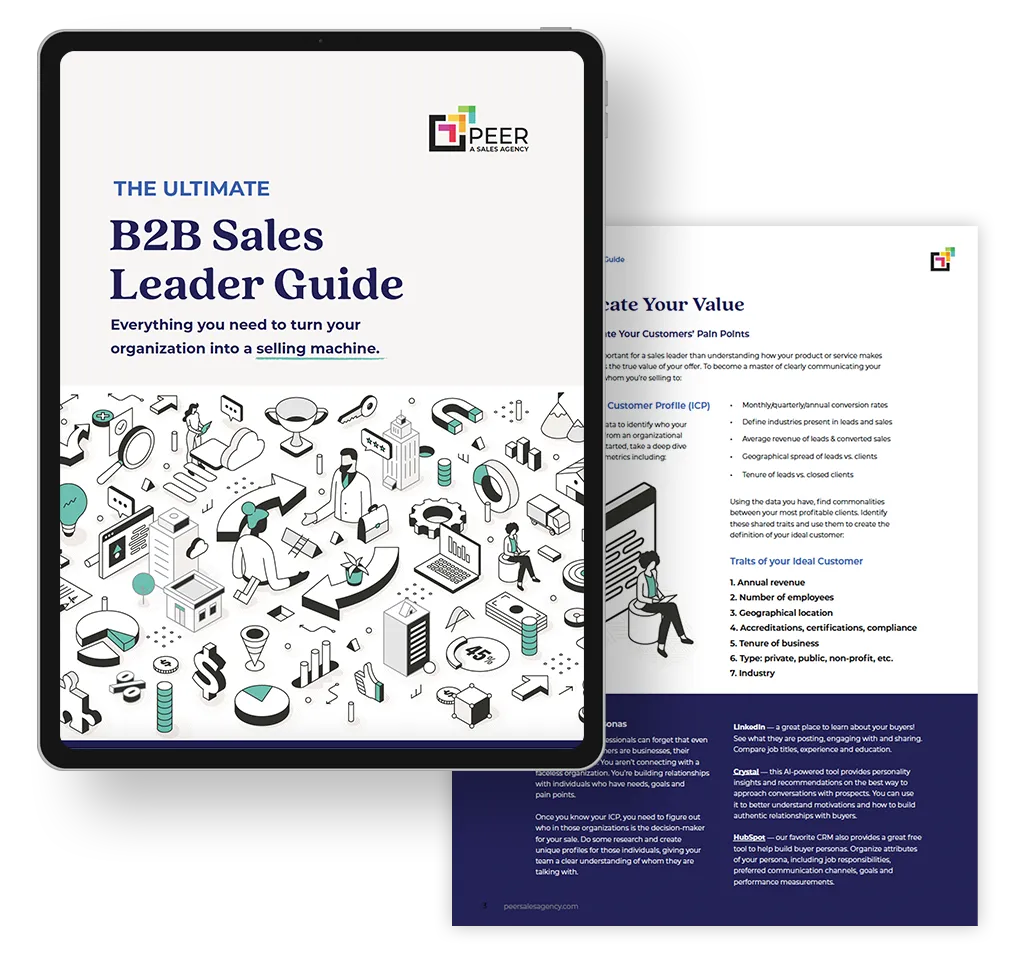How many hats do you wear in a day?
66% of small- or medium-sized business owners are responsible for at least three key areas of their business: operations, marketing, HR, sales, finance, and so on. It’s just the nature of the beast, and this is especially true for founders who are also the entire sales team.
So, when the time finally comes to lift out of the day-to-day and start to scale, how do you make sure that everything you learned from your time in the trenches gets installed in your next sales leader?
Enter the Sales Playbook.
What is a Sales Playbook and Why Do I Need One?
A sales playbook is a comprehensive guide outlining a sales team’s strategies, processes, and best practices. It serves as a process roadmap, providing a step-by-step approach to approaching prospects, nurturing leads, and closing deals.
Having a sales playbook in place allows sales teams to get a clear understanding of their goals and objectives. It helps install the strategies and techniques that will help them achieve those goals. A good sales playbook provides a common framework that all team members can follow, ensuring everyone is on the same page and working towards a common objective.
Plus, it takes a lot of the stress out of onboarding new sales team members. It provides new reps with a proven approach to selling your specific solution and guides them through the various stages of your sales process. This not only helps them ramp up faster but also ensures that they’re adhering to the techniques and strategies that have been successful in the past.
Sales playbooks are good for leadership, too. By using a consistent framework and process, it becomes easier to identify areas for improvement and provide targeted coaching and training.
How B2B Sales Playbooks Are Different
B2B sales playbooks are different from playbooks designed for B2C or DTC (Direct-to-Consumer) sales teams.
The target audience and the nature of the B2B sales process are distinct. B2B sales typically involve relationship building, complex problem sets, longer sales cycles, and multiple decision-makers. B2B and DTC sales are much faster and more transactional, and while you’ll need to build up a good brand reputation, you won’t need to worry so much about helping your sales reps build their own personal brand.
Another key difference lies in the sales messaging and value proposition. B2B sales playbooks often need to highlight specific business benefits and return on investment (ROI) that the product or service offers to your prospect.
B2B sales playbooks tend to have a more consultative approach, emphasizing the salesperson’s expertise and ability to provide tailored solutions to meet the client’s unique needs. On the other hand, B2C playbooks may prioritize persuasive techniques and creating brand affinity.
7 Must-Haves for Every Sales Playbook
You can create a sales playbook that’s as granular or as overarching as you want. You can create different sales playbooks for each stage of the sales funnel, each segment of your audience, or each use-case or “job to be done” to which your solution applies.
No matter how nitty-gritty you decide to get, there are seven key components that should be included in all your sales playbooks, especially B2B sales playbooks. These components will help you create a winning sales strategy that aligns with your business goals and maximizes your sales team’s performance.
1. Your Sales Process/Workflow
Establishing a sales process and workflow is crucial when training new salespeople or scaling your sales organization. It ensures consistency, efficiency, and measurable results, so this is the first thing to put in your sales playbook.
Outline the necessary steps, from prospecting to closing, for your specific pipeline to create uniformity of process across the team. Give a list of your sales tools and what they’re for. This consistency helps build trust with potential customers and ensures a seamless experience regardless of who they interact with.
Map it out. Having a clear roadmap by day, funnel stage, lifecycle stage, or lead status allows salespeople to prioritize their activities, leading to better time management and increased productivity. It also enables sales managers to identify bottlenecks or areas for improvement.
Establishing and continuously improving your sales process and workflow sets the foundation for success in sales. It enhances team performance, boosts customer satisfaction, and drives revenue growth.
Create sales plays for each of the four main stages of a deal:
- Prospecting
- Discovery/Demo
- Solutions Engineering/Proposal
- Customer/Client Success & Renewal
2. Company Overview Slicks
A company overview slick is a vital asset to include in all your sales playbooks, especially a B2B sales playbook. These one-sheets should be informative and visually engaging to capture attention and provide potential clients with essential information about your company.
A well-designed slick can instantly capture the attention of your prospects and make a positive first impression. It showcases your brand and gives a quick glimpse into what your company offers. Make sure your overview slick highlights your core strengths, expertise, and competitive advantages in a concise manner.
“People don’t buy the best products. They buy the products they can understand the fastest.”
-Donald Miller
Make sure this slick hits the high points: your company’s products or services, industry experience, target market, and key differentiators. Simplify the complex information to help prospects quickly grasp the fundamental aspects of your business.
Don’t forget a dab of social proof. Include a client testimonial or industry award to help establish credibility and build trust with potential customers.
In this part of your sales play, the company overview slick is typically used during initial client interactions, presentations, proposals, or as a leave-behind after a meeting. Sales representatives can leverage the company overview slick during presentations, meetings, trade shows and conferences, or networking events. It can also be a quick, internal reference tool to guide their discussions and ensure consistent messaging across the sales team.
3. Product and Services Slicks
Product and service slicks play a similar role as the company overview slick, but they dive a layer deeper into a specific product or use case. As you build out a more detailed sales playbook, these slicks provide a clear, concise, and easy-to-understand business case for what your reps are trying to sell. They eliminate unnecessary jargon and present information in a visually engaging manner, making it easier for your audience to grasp the value you offer.
In a competitive market, these more specific slicks can help differentiate your offering from competitors. Use these product or service slicks to highlight unique selling points, niche use cases, key features, and the big benefits that set your product or service apart and demonstrate why it’s the best choice in the market.
When it comes to using product and service slicks in the sales process, they’re most effective in the middle of the funnel. Once a prospect is generally aware of who you are and what you do, you can start to take a deeper dive and showcase more specific solutions.
Product and service slicks are powerful collateral during sales pitches, presentations, or meetings with potential clients. They can also be shared digitally on your website, social media platforms, or via email, allowing prospects to explore your offering at their convenience.
4. Buyer Personas & Your Messaging Matrix
Buyer personas and messaging matrices are must-haves – and not just for the marketing team. To be successful, every sales team needs to have a firm understanding of who they’re talking to, how those people buy, and what to say to keep them interested.
Having buyer personas in your sales playbook allows you to align your efforts with the right audience, increasing the effectiveness of your sales strategy. By addressing their unique challenges, you establish credibility and build trust, positioning yourself as a valuable solution provider.
Your messaging matrix ensures consistency in your communication across different channels and touchpoints. It outlines the key messages, differentiators, and value propositions that resonate with your target audience. By including your messaging matrix in your sales playbook, you help your sales team maintain a unified voice and brand identity, creating a cohesive customer experience.
Your team should utilize these assets throughout the entire sales process. From prospecting and lead generation to nurturing and closing deals, buyer personas and key messaging help you build and maintain strong relationships with potential customers.
5. Sales Scripts, Talk Tracks, and Templates
Getting a little more granular, sales scripts and templates also belong in your sales playbook. These helpful conversation starters ensure even more consistency in messaging, and they also serve as a guide to help your sales team navigate through different stages of the sales process.
Call scripts and talk tracks are essential, even if your team only uses them to practice or as a general guideline. These guides help your salespeople communicate confidently and stay focused on the “next right thing” during phone conversations or chat sessions with prospects. Outline some key talking points and responses to common objections, and have your team practice.
Speaking of those chat sessions, messaging scripts for your website chat or LinkedIn mail are equally important in today’s digital landscape. They provide a standardized format for salespeople to engage with prospects through various messaging platforms, such as social media, live chat, or even text messaging. That’s part of your sales playbook, too!
Don’t forget about email templates. Use templated emails and CRM automation with key personalization elements to enable salespeople to craft well-structured emails, scheduled in advance, that still feel like a personal touch. These templates provide a starting point, allowing salespeople to modify and customize the content to suit the specific needs of each prospect. This saves time and ensures that important information is included in every email.
These scripts and templates can be used throughout the sales process, and you can create a specific sequence of calls, messages, and emails for each segment of your sales process.
6. Presentation Decks
No sales playbook is complete without a few decks. Having a well-structured and visually appealing presentation deck for each stage of your pipeline where a client-facing meeting is likely will help you leave a lasting impression and keep your sales rep focused on a proven structure for the meeting.
Presentation decks allow your reps to showcase your company’s products or services, highlight key features and benefits, and proactively address any potential objections or concerns. Decks help your reps present information in a clear and organized manner, ensuring that your audience understands and retains the information you are conveying.
Presentation decks are most commonly used during discovery conversations, demos, stakeholder meetings, pitches, and product demonstrations. These assets can be shared electronically or printed out, allowing you to reach a wider audience and make a lasting impression even after the meeting is over.
Presentation decks make even the smallest teams look more professional, facilitate effective communication, and provide a structure for your sales meetings. Incorporating well-designed presentation decks into your sales process can greatly improve your chances of success.
7. KPIs and Goals
“That which is measured improves. That which is measured and reported improves exponentially.”
– Professor Karl Pearson
Put your expectations and sales goals directly in our sales playbook. Clearly defined KPIs, goals, and expectations provide a roadmap for sales reps, aligning their efforts with the overall objectives of the company. This ensures that everyone is working towards the same desired outcome.
Being transparent and upfront about the activities and time you expect sales teams to invest helps them avoid wasting time on irrelevant or low-impact activities. Clearly defined expectations enable managers to hold sales reps accountable for their performance. With measurable KPIs and goals in place, it becomes easier to track progress, identify areas of improvement, and provide targeted feedback and coaching.
Motivation matters, too. Having clear objectives and targets to strive for can greatly motivate sales reps. It provides them with a sense of purpose and accomplishment, driving them to work harder and smarter to achieve their sales goals.
Deploying & Training Your Sales Playbook
Once you’ve created your B2B sales playbook, you’ll need to implement it to see its value.
Start with comprehensive training and onboarding to your sales team. This involves thoroughly familiarizing them with the playbook’s contents, including the sales process, messaging, objection handling, and other key elements. Conduct regular training sessions and workshops to reinforce the playbook’s principles and equip your sales team with the necessary skills to effectively utilize it. Additionally, provide ongoing coaching and support to address any queries or challenges that may arise during its implementation.
Encourage your sales team to use role play and test each other with new objections. Pull your marketing team in to play the prospects, too, to help foster better sales <> marketing alignment.
The success of your sales playbook relies on its continuous evaluation and improvement. Regularly review the playbook’s performance and gather feedback from your sales team to identify any areas for enhancement. Effective sales playbooks are a living document, so adapt the playbook as you gather new insights and learnings from your sales efforts, industry trends, and market dynamics.
More tips, tools, and tactics to win more deals
Today’s sales leaders have to be product experts, communication gurus, and motivational mentors. This guide will give you tools and tips to help your organization create audience clarity, nurture relationships with potential customers, and leverage the latest innovations to really stand out. Download the Ultimate Guide for B2B Sales Leaders and turn your organization into a money-printing machine.



